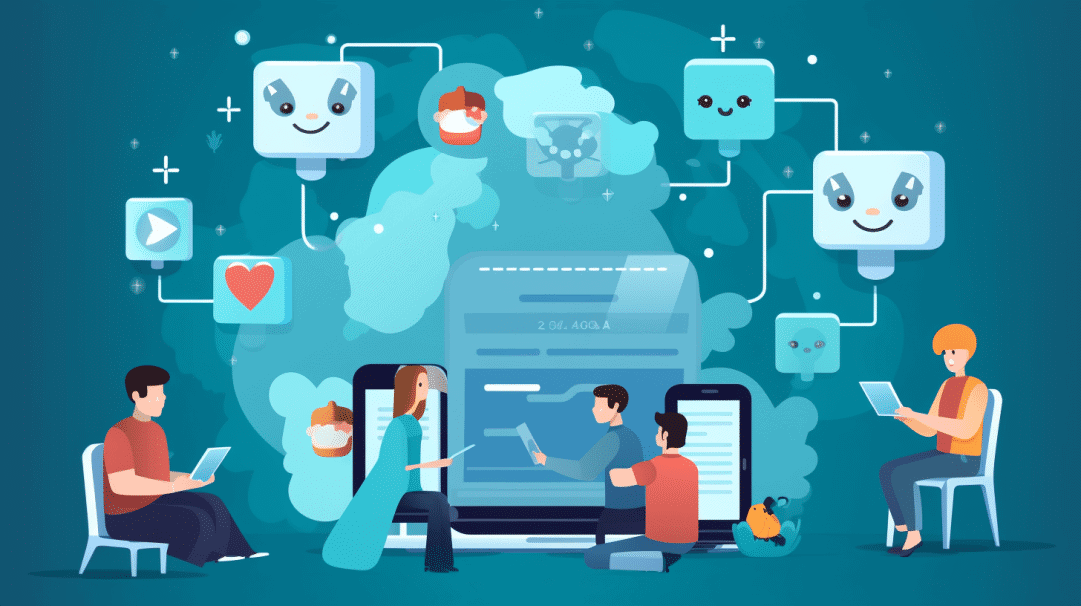How Nonprofit Chatbots Can Help Save Time and Resources
1. How Nonprofit Chatbots Are Revolutionizing Charitable Operations
In the nonprofit sector, technology has become a cornerstone for enhancing efficiency and engagement. Among the various tech solutions, nonprofit chatbots are emerging as a transformative tool. These AI-driven platforms are reshaping how charities interact with donors, manage internal processes, and achieve their mission goals.
2. Demystifying Nonprofit Chatbots: The Unseen Helpers
Chatbots, in essence, are software applications that simulate human conversations. They interact with users, answer queries, provide instructions, and in the context of nonprofits, can even solicit for donations. Powered by AI, chatbots can simulate human-like conversations and intelligently respond to inquiries. From customer service to personalized marketing, chatbots are becoming ubiquitous in various sectors, stretching beyond the confines of for-profit organizations.
3. Chatbots: A Potential Game Changer for Nonprofits
As this essay unfolds, a clear proposition will be forwarded – chatbots can indeed be a game-changer in helping nonprofits save time, resources, and substantially enhance engagement with their audience. Achieving these efficiencies can exponentially increase the impact of nonprofits, enabling them to direct more resources to the cause they champion. Leveraging technology, particularly AI chat for nonprofits, can therefore open up profound opportunities for charitable bodies and society as a whole. The digital transformation has only begun, and it is empowering nonprofits to do more and achieve more.

4. Comprehensive Understanding of Chatbots: Exploring How Nonprofit Chatbots Work
Chatbots, or “nonprofit organization chatbots” as are becoming known in charitable circles, are interactive software applications that mimic human conversations. They utilize machine learning and natural language processing to deliver a dynamic and engaging user experience. The more interaction a chatbot has with users, the better it becomes at anticipating user needs and providing accurate responses.
Main Features of Nonprofit Chatbots
Chatbots or “nonprofit messaging bots” possess certain key features that make them incredibly useful in a nonprofit setting. Firstly, they have automated responses. The marked feature of automation allows chatbots to deliver immediate responses to common queries, thus fostering timely and efficient communication. This characteristic is invaluable to nonprofits, as they often rely heavily on volunteer work and are strapped for resources. Further, these chatbots can learn from past conversations, utilizing machine learning algorithms to improve their responses over time. In short, chatbots serve as an “AI support for charity.” They possess the ability to process and understand natural language inputs from users, this feature allows them to engage with users in a manner that’s conversational and intuitive.
Deployments of Chatbots in Nonprofit Setting
Nonprofits have found myriad innovative ways to employ chatbots or “Conversational AI for nonprofits” in their operations.
They are primarily used for donor engagement, where they can answer queries in real-time and encourage potential donors to contribute. They can also collect donor information, streamlining future communication efforts. Additionally, “donation chatbot systems” can be used to facilitate donation processes. With integrated payment systems, these chatbots can accept and process donations instantly. This increases the convenience for donors and accelerates the fundraising processes for nonprofit organizations.
Secondly, they serve as a “volunteer coordination bot”, managing volunteers by organizing schedules, conveying vital information, and providing prompt responses to any inquiries. Furthermore, chatbots have also found a place in internal communication, where they can be used to streamline information dissemination among the staff and foster a cooperative work environment. Finally, chatbots can also serve as a “fundraising automation tool,” spearheading fundraising campaigns by reaching a broader audience, engaging individuals through personalized messages, and driving up the donation figures. Indeed, the intersection of “Chatbot in philanthropy” is a promising one and is set to redefine how nonprofits operate, enhancing efficiency and maximizing engagement on the digital front.
5. Specific Ways in which Nonprofit Chatbots can Streamline Operations
Chatbots, as more than just an “AI chat for nonprofits,” have the potential to significantly optimize operations for charitable organizations. They can automate repetitive tasks, provide immediate and accessible support, assist in fundraising activities, and expedite data collection and analysis.
Automation of Repetitive Tasks
These bots, also known as “charity chat automation” tools, can automate tasks that were previously manually handled by staff members. This is of particular importance for nonprofits. Many operations such as answering frequently asked questions or managing registration forms are repetitive in nature. Delegating these duties to a “nonprofit organization chatbot” frees up valuable human resources. By automating these tasks, nonprofits can ensure that their human capital is allocated more directly towards the cause at hand.
Instant and Accessible Customer Service
Nonprofits can also use the “nonprofit communication bot” feature of chatbots to provide instant and accessible customer service. With chatbots, nonprofits can ensure their stakeholders receive immediate responses, regardless of the time of day. This drastically improves the user experience, resulting in higher donor retention and increased satisfaction among volunteers.
Assistance in Fundraising Activities
A “fundraising automation tool,” chatbots can play an integral role in raising funds for nonprofits. They can send out automated messages to potential donors, relaying information about the cause, and directing them towards the donation page. Furthermore, nonprofits can use chatbots to run donation campaigns on social media platforms and other digital forums, thereby, opening avenues to a wider pool of prospective donors.
Facilitation of Data Collection and Analysis
The final element in this discussion is the role chatbots can play in data collection and analysis. They can collect data from users, tracking interactions, and user behavior. This information can then be analyzed to understand patterns, preferences and to enhance future engagement strategies. A “social cause bot” can be significantly instrumental in this respect. The role of chatbots as a “nonprofit digital assistant” extends beyond just communication and automation. They wield enormous potential in streamlining operations, enhancing the reach, and increasing the impact of nonprofit organizations. Truly, “chatbots for NGO” represent a significant stride on the path of digital transformation for nonprofits.
6. Case Studies and Examples: Real-life Success Stories of Nonprofits Benefiting from Chatbots
The real-world applications of “AI for charities” provide illuminating insights into the transformative role that chatbots play for nonprofits. This section will showcase some of the most striking examples of how nonprofits have successfully integrated chatbots into their operations, and the significant advantages they have reaped.
WaterAid
WaterAid, a nonprofit focused on improving access to clean water and sanitation, is a prime example of using “donation chatbot systems”. They utilized chatbots to engage with potential donors on Facebook Messenger. The bot asked engaging questions about the user’s water consumption habits, providing insights on water scarcity and how the donor’s contribution could make a difference. The response was impressive, resulting in an 8-fold return on their investment.
World Health Organization
The World Health Organization took advantage of “nonprofit communication bots” to disseminate real-time information about COVID-19. Their chatbot on WhatsApp and Messenger fielded millions of queries, ensuring people globally had access to accurate information. This timely application of “social cause bots” is a testament to the potential of chatbots in managing communication during critical situations.

Save the Children
Save the Children, an NGO focused on child rights, used “chatbots for NGO” to increase donations during end-of-year fundraising. Their bot, dubbed ‘the support bot,’ enabled them to engage with potential donors and direct them toward a simplified and streamlined donation process. The implementation of this “nonprofit digital assistant” resulted in a 25% conversion rate– a remarkable achievement.
The United Nations International Children’s Fund (UNICEF)
UNICEF has been deploying what could be called a “volunteer coordination bot.” They launched a chatbot called U-Report to gather feedback and opinions from young people around the world on crucial issues. The responses are utilized to shape policies and programs, emphasizing the potential of chatbots in collecting and analyzing data. These real-world examples elucidate the transformative role that “Conversational AI for nonprofits” can play. Whether it’s engaging donors, spreading awareness, or coordinating volunteers, chatbots provide numerous advantages to nonprofits, proving that the growing importance of “Chatbot in philanthropy” is more than justifiable.
7. Wrapping Up: The Transformative Power of Nonprofit Chatbots
Recap of Key Points
In conclusion, the implementation of nonprofit chatbots is a valuable strategy to improve efficiency, streamline operations, and enhance engagement. As discussed, chatbots, or “AI for charities,” serve numerous purposes. Whether it’s automating repetitive tasks, providing instant and accessible customer service, assisting in fundraising activities, or facilitating data collection and analysis, the power of “charity chat automation” is unquestionable. We delved into specific success stories, including WaterAid, WHO, Save the Children, and UNICEF, where integrating “nonprofit organization chatbot” into their operations led to significant improvements in efficiency and effectiveness.
Call to Action
As nonprofits navigate the digital landscape, it is both timely and pertinent to consider integrating “AI chat for nonprofits” into their digital strategy. The advantages that these organizations stand to gain from adopting nonprofit chatbots are multifaceted and significant. However, as with any digital tool, implementing chatbots may bring its own set of challenges. Therefore, strategic planning in their deployment is key. It is essential for nonprofits to define the scope of usage for their chatbots, train staff to use them effectively, and conduct routine checks and improvements based on the collected data. The digital revolution is here and nonprofits, in the same stride as their corporate counterparts, are the beneficiaries of this technological crescendo. By leveraging chatbots, nonprofits can ensure they are making the best use of their resources, thereby focusing more intently on the cause at hand. Indeed, as the narrative of digital transformation and nonprofits unrolls, there is no better time to explore chatbot solutions for nonprofits. This, undoubtedly, is a zestful cue to action in the throbbing heart of the digital divide.

